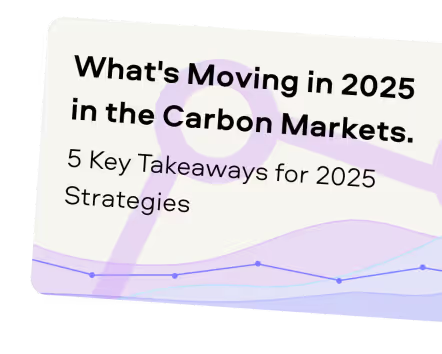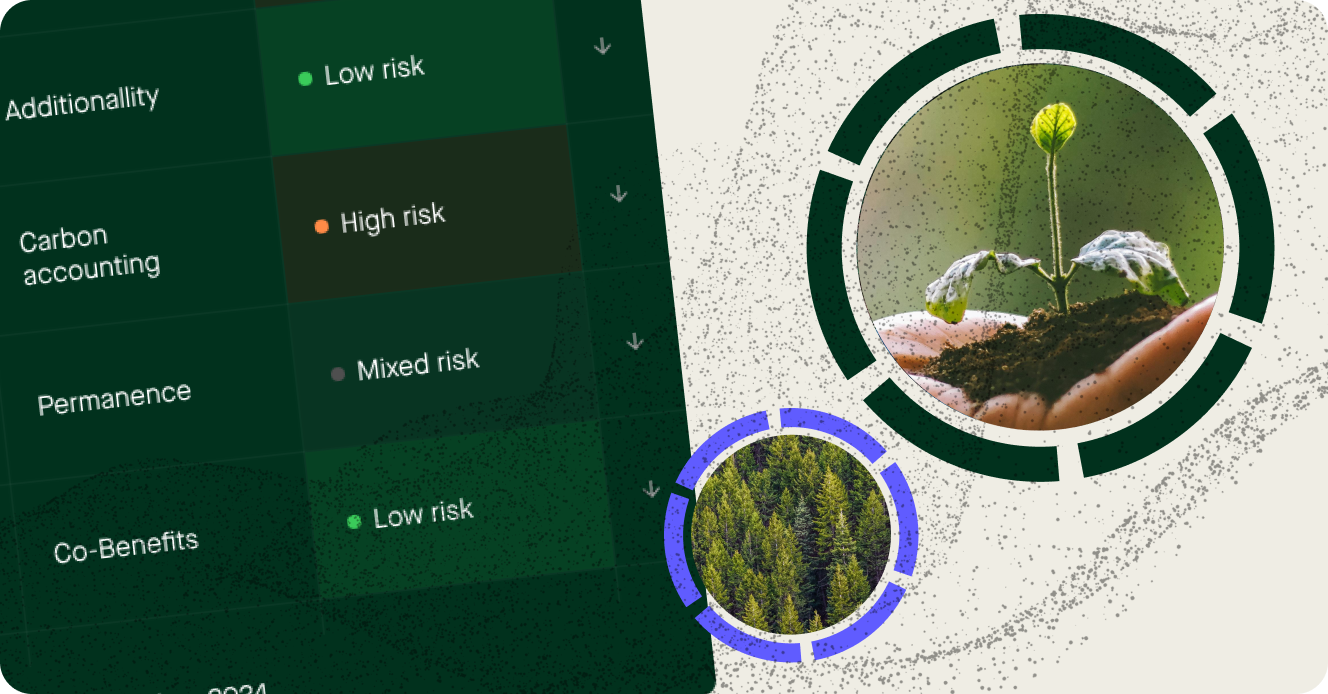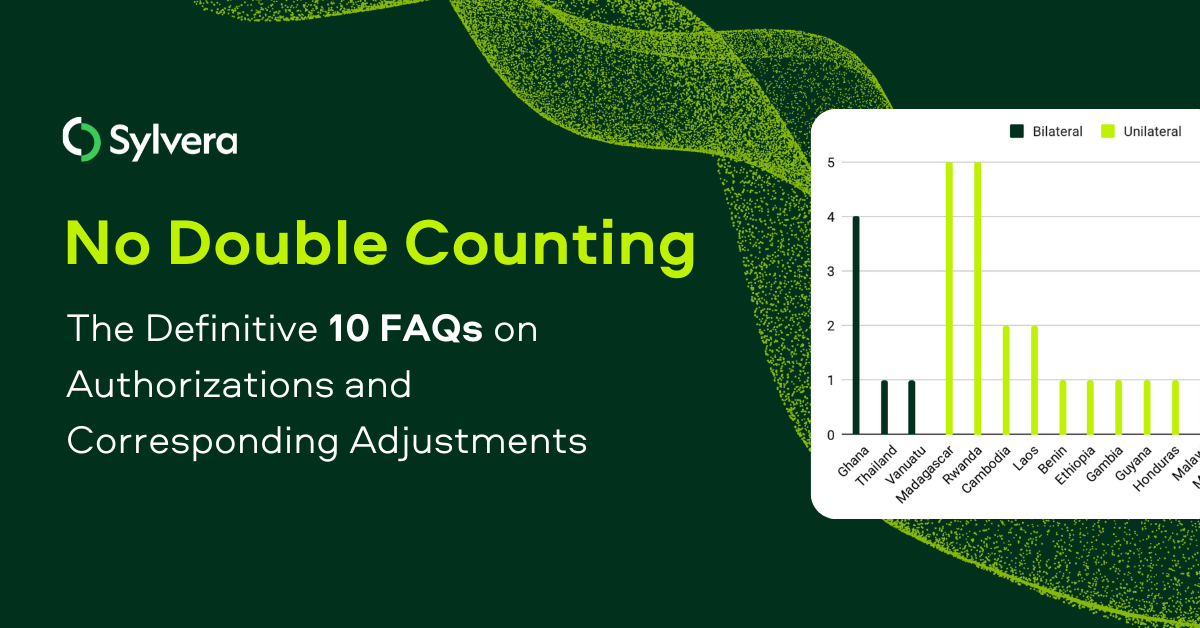“Over the years we’ve invested significantly in our field data team - focusing on producing trusted ratings. While this ensures the accuracy of our Ratings, it doesn’t allow the scale across the thousands of projects that buyers are considering.”
For more information on carbon credit procurement trends, read our "Key Takeaways for 2025" article. We share five, data-backed tips to improve your procurement strategy.

One more thing: Connect to Supply customers also get access to the rest of Sylvera's tools. That means you can easily see project ratings and evaluate an individual project's strengths, procure quality carbon credits, and even monitor project activity (particularly if you’ve invested at the pre-issuance stage.)
Book a free demo of Sylvera to see our platform's procurement and reporting features in action.
Carbon market participants face a common challenge: making multi-year commitments in a market characterized by volatility, policy uncertainty, and evolution.
Whether you're a corporate buyer planning 2026 procurement, an investor evaluating a $10M deployment, or a project developer negotiating offtake terms, you need more than current spot prices. You need forward visibility into how the voluntary carbon market (VCM) will evolve under different scenarios.
Sylvera’s Market Forecasts deliver bottom-up carbon market scenarios through 2050, providing the forward curves, supply-demand analysis, and scenario planning that stakeholders need to secure high-quality carbon credits with confidence.
Here's how five key carbon market players are using this intelligence to navigate the market and capitalize on exciting opportunities.
.jpg)
1. Corporate buyers: Planning multi-year budgets and optimizing timing for the best carbon offset prices
Corporate buyers face pressure from multiple directions. Finance wants predictable budgets. Leadership wants credible net-zero strategies. Communications teams need to defend procurement choices. All of this in a market where prices can swing based on project characteristics.
How do we plan defensible multi-year budgets?
When your CFO asks why carbon credit budgets are increasing 15% annually through 2030, "Because the market is volatile” isn't sufficient. You need to show the specific drivers: supply constraints in your target project mix, CORSIA implementation creating new demand, or premiums being applied to higher quality credits as buyer scrutiny increases.
Market Forecasts provide transparent supply and demand impact by project type and region. You can show leadership exactly why your target portfolio (e.g, 70% BBB+ forestry, 30% biochar) costs $X in 2026 and $Y in 2029, with clear explanations of the market dynamics driving those changes.
For example, a corporate buyer could use this approach to secure its 3-year budget with built-in variance bands. Instead of committing to fixed per-tonne pricing, they presented base-case scenarios with ranges tied to specific market drivers. When actual 2027 carbon pricing came in at the high end of projections due to faster CORSIA scaling, the variance was expected rather than a budget surprise (requiring explanation).
Where should we time our procurement to optimize costs?
Not all project types face the same supply-demand dynamics. Some categories show tightening supply and rising prices, making early commitment valuable. Others show improving technology economics or expanding supply, where the wait-and-see approach will likely reduce costs.
Scenario analysis reveals these timing opportunities. If medium and high-demand scenarios both show significant price increases for your target project type by 2028, that's a clear signal to accelerate procurement.
On the other hand, if even high-demand scenarios show stable or declining pricing, waiting might optimize your budget throughout the global carbon market.
How do we identify and mitigate cost risk flags?
The most sophisticated buyers don't just plan for base-case scenarios. They identify specific risks that could affect their budgets and develop mitigation strategies.
Market Forecasts help procurement teams spot these risks early: supply-demand imbalances emerging in specific geographies, compliance scheme changes affecting credit eligibility, or quality premiums widening beyond budgeted assumptions.
So, with 12-18 months of advance warning, teams can adjust procurement strategies, diversify project type exposure, or restructure offtake agreements before risks materialize.
.jpg)
2. Investors: Timing deployment and managing portfolio risk in volatile carbon markets
Carbon market investors are operating in a market where timing and project selection determine returns. Should you support forestry projects or direct air capture projects, for instance? And should you support them now on in two years?
Wait too long on supply-constrained project types and you miss the opportunity entirely. Miss the quality threshold buyers demand, and your credits sit unsold.
On the other hand, deploy capital too early in, for example, declining-cost technologies, and you'll pay a higher direct carbon price.
When should we deploy capital across different project types?
Forward cost curves reveal where pricing trajectories diverge. High-quality forestry projects in Article 6-ready countries might show tightening supply and higher prices, signaling a pre-buy opportunity.
Meanwhile, biochar projects might show declining unit costs as technology scales, suggesting patience pays off.
So, an investor would use this intelligence to restructure their deployment timeline. For example, instead of spreading $15M uniformly across 2026-2028, they could accelerate investment in ARR projects (anticipating supply constraints) while delaying biochar deployment (expecting cost declines). By 2028, this timing optimization could generate an additional return compared to their original plan, which they’d be able to forecast to leadership.
How do we pressure-test our investment thesis?
Before IC meetings, investment teams need to demonstrate their assumptions hold across different market conditions. Market Forecasts provide low, medium, and high demand scenarios with explicit drivers. For example, CORSIA scaling timelines, Article 6 implementation, sovereign buyer entry, and compliance scheme expansion.
This scenario analysis helps funds structure deals with appropriate risk-reward balance. If low-demand scenarios show prices below your hurdle rate, you can negotiate prepayment discounts or volume flexibility. If high-demand scenarios show significant upside, you can structure participation mechanisms that capture that value.
Which project types offer the best risk-adjusted returns?
Price dispersion matters as much as average pricing. A project type trading at $20-$40 has different risk characteristics than one trading at $28-$32, even if both average $30/tonne.
Market Forecasts explicitly model price ranges within project categories, helping investors understand not just expected returns but variance around those expectations. This intelligence informs portfolio construction: high-variance project types might warrant smaller allocations or require different deal structures than stable, predictable categories.
3. Project developers: Strengthening fundraising and offtake negotiations to create more carbon credit supply
Project developers operate with a fundamental challenge: they need capital and offtake commitments before credits issue, but investors and buyers want confidence in future revenue.
In such a market, "We predict credits will trade at $30/tonne" statements don't inspire confidence when developers have obvious incentives to be optimistic and investors are inherently risk-averse.
How do we model credible revenue projections for investors?
Fundraising success often hinges on revenue assumptions. Too conservative, and project economics don't support the capital raise. Too optimistic, and investors dismiss projections as wishful thinking.
Market Forecasts let developers present revenue scenarios grounded in third-party analysis rather than internal assumptions. For example an ARR developer could use this approach to present three scenarios to investors: conservative case aligned with low-demand pricing ($18), base case using medium-demand projections ($24), and upside case tied to strong Article 6 implementation ($32).
Investors would acknowledge the transparency and the grounding in recognized scenario modelling, with more likelihood of closing an agreement at better terms than comparable carbon projects relying solely on internal projections.
How do we negotiate offtake agreements with pricing confidence?
With offtake negotiations, buyers want price certainty and downside protection. Developers need sufficient revenue to justify project investment. Forward curves help both parties find mutually beneficial structures.
Imagine that a biochar developer used Market Forecasts in offtake negotiations with a corporate buyer. Rather than debating whether credits would trade at $180 or $210 per tonne of carbon dioxide equivalent in 2028, they could agree to a deal with pricing tied to scenario outcomes. For example, a base price of $185/tonne with adjustments if market conditions track high or low scenarios. Both parties would see appropriate risk-sharing rather than one side bearing all pricing risk.
Which project types and geographies offer the best market access?
Forward visibility into supply-demand balance helps developers make smarter project selection decisions. A region showing oversupply and declining prices might still be operationally attractive, but developers need to understand they're building in a declining-price environment requiring different financial structures.
Conversely, project types showing supply constraints and rising prices justify higher development costs and more aggressive growth strategies. A developer could use this intelligence to prioritize expansion in, for example, African ARR projects over South American alternatives, anticipating supply-demand dynamics that would support premium pricing in their target geography.
.jpg)
4. Governments and compliance: Long-term policy planning to minimize carbon dioxide and other greenhouse gases
Governments and compliance buyers face procurement timelines that extend decades, they're subject to public scrutiny and audit requirements, and their purchasing decisions must align with complex policy frameworks that support net zero targets and combat climate change.
How do we budget for multi-decade compliance obligations?
Aviation sector compliance under CORSIA, national carbon budget targets, and Article 6 engagement all create long-term procurement commitments. Governments need to understand not just 2025 costs but how their compliance strategies will evolve through 2040 and beyond.
Market Forecasts provide supply-demand projections through 2050, helping sovereign buyers model the full lifecycle costs of different compliance approaches. This intelligence informs decisions about domestic project development versus international credit purchases, timing of procurement across compliance periods, and budget allocation across different credit categories.
How do Article 6 and compliance schemes interact with voluntary markets?
One of the most complex questions facing policy planners: How will Article 6 implementation affect credit availability and pricing across voluntary and compliance markets?
Market Forecasts explicitly model the interaction between compliance demand (CORSIA, Article 6, domestic programs) and voluntary market demand. This helps governments understand how their purchasing decisions affect market dynamics, which credit categories face supply constraints under different policy scenarios, and how to optimize purchasing strategies across market segments.
What are the policy change impacts on our procurement strategy?
Policy frameworks continue evolving. CORSIA implementation timelines shift. Article 6 authorization approaches change. New compliance schemes emerge. Each change potentially affects credit eligibility, supply availability, and pricing.
Scenario analysis helps governments assess how different policy paths affect their compliance costs and credit availability. This intelligence informs both their own policy development and their procurement strategies within existing frameworks.
5. Brokers and intermediaries: Supporting advisory and portfolio offerings with data-backed recommendations
Brokers and intermediaries are also using Market Forecasts to strengthen their client advisory capabilities.
How do brokers add value beyond transaction execution?
In a maturing market, brokers who simply connect buyers and sellers face margin compression. The intermediaries who thrive provide genuine advisory value: helping clients understand market dynamics, timing procurement strategically, and structuring deals that optimize risk-return trade-offs.
Market Forecasts provide the analytical foundation for this advisory role. Rather than relying on anecdotal market knowledge or dated reports, brokers can show clients data-driven projections for different project types (both carbon capture initiatives and carbon removal technologies), scenario analysis for risk assessment, and transparent methodologies supporting their recommendations.
How do intermediaries support client decision-making across market cycles?
Clients need different intelligence at different points in procurement cycles. During budget planning, they need multi-year projections. During active procurement, they need current market positioning. During portfolio review, they need performance attribution.
Market Forecasts provide intelligence across these different contexts, helping intermediaries provide consistent, data-backed guidance regardless of where clients are in their decision-making process.
Replace guesswork with scenario-based intelligence
Across all these use cases, Market Forecasts deliver the same core value: replacing single-point forecasts and anecdotal market knowledge with rigorous, transparent scenario analysis grounded in bottom-up modeling of market data.
Whether you're timing a $10M investment, defending a 3-year budget to your CFO, negotiating an offtake agreement, or planning a compliance strategy, the challenge is similar: making multi-year commitments under uncertainty.
Market Forecasts give you the forward visibility to make those decisions with confidence, understand the risks you're taking, and adjust strategies as market conditions evolve.
About Market Forecasts
Market Forecasts deliver comprehensive carbon market scenarios through 2050, giving you the forward visibility needed to navigate uncertainty with confidence.
Comprehensive market outlook across scenarios
Get granular pricing, supply, and demand projections for 10+ project types. From nature-based solutions (ARR, REDD+, IFM) to engineered removals (BECCS, DACCS, Biochar), across global regions through 2050.
Low, medium, and high demand scenarios help you stress-test assumptions and plan for different market conditions.
Bottom-up methodology grounded in real market data
Unlike top-down forecasts, our agent-based model simulates individual buyer behavior based on preferences, compliance obligations, and purchasing patterns.
Calibrated to 2024 market conditions and fed by live integrations with approximately 20 registries and 40,000+ company profiles, Market Forecasts reflects actual market structure and participant behavior.
Actionable insights, instantly accessible
Download standardized scenarios with full assumptions, charts, and data tables. Share credible forward curves with investment committees, boards, or counterparties without waiting for bespoke analysis.
Ready to see how Market Forecasts can support your specific use case? Schedule a demo to explore scenarios tailored to your decision-making needs.





.jpg)









